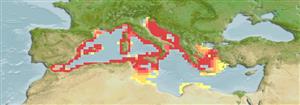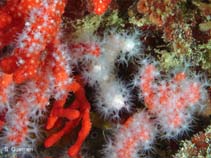Advertisement
Corallium rubrum (Linnaeus, 1758)
Sardinia coral| Native range | All suitable habitat | Point map | Year 2050 |

|
| This map was computer-generated and has not yet been reviewed. |
| Corallium rubrum AquaMaps Data sources: GBIF OBIS |
Greece country information
Common names:
[No common name]
Occurrence: native
Salinity: marine
Abundance: | Ref:
Importance: commercial | Ref:
Aquaculture: never/rarely | Ref:
Regulations: no regulations | Ref:
Uses: no uses
Comments:
National Checklist:
Country Information: https://www.cia.gov/library/publications/resources/the-world-factbook/geos/gr.html
National Fisheries Authority:
Occurrences: Occurrences Point map
Main Ref: Carpine, C., 1987
National Database:
Occurrence: native
Salinity: marine
Abundance: | Ref:
Importance: commercial | Ref:
Aquaculture: never/rarely | Ref:
Regulations: no regulations | Ref:
Uses: no uses
Comments:
National Checklist:
Country Information: https://www.cia.gov/library/publications/resources/the-world-factbook/geos/gr.html
National Fisheries Authority:
Occurrences: Occurrences Point map
Main Ref: Carpine, C., 1987
National Database:
Common names from other countries
Classification / Names Tên thường gặp | Các synonym ( Các tên trùng) | Catalog of Fishes (gen., sp.) | ITIS | CoL | WoRMS
Environment: milieu / climate zone / depth range / distribution range Sinh thái học
; Mức độ sâu 10 - 1016 m (Tài liệu tham khảo 66603), usually 10 - 100 m (Tài liệu tham khảo 358). Subtropical
Distribution Các nước | Các khu vực của FAO | Các hệ sinh thái | Những lần xuất hiện | Những chỉ dẫn
Eastern Atlantic and the Mediterranean.
Length at first maturity / Bộ gần gũi / Weight / Age
Maturity: Lm ? range ? - ? cm Max length : 3.0 cm COLD con đực/không giới tính; (Tài liệu tham khảo 364)
Short description Hình thái học
Arborescent colonies, with growth irregularly divided into all directions, provided with a Hard skeleton calcareous: can exceed 50 cm, but in general less developed. The surface of the ramifications is not smooth. Polyp: reach the diameter of 0.15 cm; they are white and translucent, the cortical fabric being of red color, seldom white or yellow. The skeleton is highly colored of red; more rarely of pink; dark; white red or to black (Ref. 358). Certain colonies: 20 cm height, but intensive fishing makes disappear the largest specimens. Diameter of the base: 3 cm at the largest specimens (Ref. 364).
Hard skeleton calcareous: can exceed 50 cm, but in general less developed. Polyp: reach the diameter of 0.15 cm. Depth: commonly 10 m of depth; currently, it is necessary to go down beyond the 30 m, generally even 40 m, and until several hundred meters of depth (Ref. 358). Maximum depth and common maximum depth from Ref. 122525. Habitat: Found in the infra- and circalittoral zones as well as bathyal zones (Ref. 85338). Sites little exposed to the solar rays: lower level of rock overhangs, anfractuosities and excavations, rock walls located at great depth (Ref. 358); conditioned by two essential criteria: the weak luminosity and the substrate. One finds it in theory only on the bed rock under conditions of reduced illumination. At the surface levels, it characterizes the biocenoses semi-obscure caves. Low, one meets it on rock cliffs or sproutings. Harvests, made more and more deeply, restrict its bathymetric distribution. (Ref. 364). Found on cave walls, vertical cliffs and overhangs (Ref. 66603). Exposure to high temperatures beyond 24°C appears to have a critical mortality effect, decreasing polyp activity and calcification rates (Ref. 129072).
Life cycle and mating behavior Chín muồi sinh dục | Sự tái sinh sản | Đẻ trứng | Eggs | Sự sinh sản | Larvae
Members of the class Anthozoa are either gonochoric or hermaphroditic. Mature gametes are shed into the coelenteron and spawned through the mouth. Life cycle: The zygote develops into a planktonic planula larva. Metamorphosis begins with early morphogenesis of tentacles, septa and pharynx before larval settlement on the aboral end.
Main reference
Các tài liệu tham khảo | Người điều phối | Người cộng tác
Göthel, H. 1992. (Tài liệu tham khảo 358)
IUCN Red List Status
(Tài liệu tham khảo 130435: Version 2024-2)
CITES status (Tài liệu tham khảo 108899)
Not Evaluated
CMS (Tài liệu tham khảo 116361)
Not Evaluated
Human uses
Các nghề cá: Tính thương mại
FAO - Các nghề cá: landings, species profile | FishSource | Biển chung quanh ta
Các công cụ
Thêm thông tin
Các nước
Các khu vực của FAO
Các hệ sinh thái
Những lần xuất hiện
Những chỉ dẫn
Stocks
Sinh thái học
Thành phần thức ăn
Các loại thức ăn
Các khu vực của FAO
Các hệ sinh thái
Những lần xuất hiện
Những chỉ dẫn
Stocks
Sinh thái học
Thành phần thức ăn
Các loại thức ăn
Tên thường gặp
Các synonym ( Các tên trùng)
Các động vật ăn mồi
Sự tái sinh sản
Chín muồi sinh dục
Đẻ trứng
Sự sinh sản
Eggs
Egg development
Các synonym ( Các tên trùng)
Các động vật ăn mồi
Sự tái sinh sản
Chín muồi sinh dục
Đẻ trứng
Sự sinh sản
Eggs
Egg development
Các nguồn internet
BHL | BOLD Systems | CISTI | DiscoverLife | FAO(Các nghề cá: species profile; publication : search) | GenBank (genome, nucleotide) | GloBI | Gomexsi | Google Books | Google Scholar | Google | PubMed | Cây Đời sống | Wikipedia (Go, tìm) | Tạp chí Zoological Record
Estimates based on models
Preferred temperature
(Ref. 115969): 13.8 - 19.6, mean 17.7 (based on 240 cells).
Thích nghi nhanh
(Tài liệu tham khảo 69278)
thấp, thời gian nhân đôi của chủng quần tối thiểu là 4.5 - 14 năm (K=0.06).
Price category
(Tài liệu tham khảo 80766):
Unknown.




